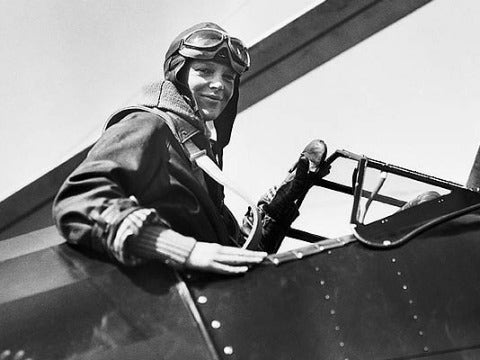Amelia Earhart: What We Can Learn From The Feminist Icon
Lessons in love from the fiercely feminist and feminine pilot ahead of her time.

It was 76 ago today that Amelia Earhart, then 39, disappeared somewhere over the Pacific Ocean. While most of us know she was a female pilot who set record after record, not everyone is aware of just how fiercely feminist, feminine and independent she truly was. So independent, in fact, that when she lectured at colleges she was very adamant that women pursue education and degrees before settling down with a marriage. She saw marriage as a cage, granted an "attractive" one, but still a cage nonetheless.
From the beginning, Earhart wasn't like other girls. Her mother didn't believe in molding her and her sister, "Pidge," into "nice little girls," and because of this, the two dressed and played like boys. It was in those early days that Earhart's sense of adventure was fostered, and her fearlessness to take flight was inevitable. She'd eventually get there, in men's boxer shorts no less, in 1918 after attending a flying exhibit in Canada where she felt the plane that dove at her "said something" to her. Two years later she would take her first flying lesson, and her true love would be realized; two years after that she'd set her first record by being the first female pilot to fly 1400 feet.
Earhart was ahead of her time in many ways. In addition to being a woman who wanted to take on the world, risk everything and sport men's underwear when she was flying, she also put relationships with men second. It was the 1920's, and although it was the flapper generation, where women were coming into their own and rebelling against the constraints of the past, still, the very notion of a woman not wanting to marry was an odd one. Even flappers wanted to find a steady fella with whom to grow old.
There appears to have been two major men in Earhart's life: the first being Sam Chapman to whom she was engaged for six years until she called it off in 1928, and George P. Putman. Putman proposed to Earhart six times before she finally accepted. Unlike many relationships of the time, she regarded hers to be one of equal partnership, and it was important to her that they were both "breadwinners," so as avoid any imbalance or unnecessary dependence on each other. She also kept her maiden name, something that was absolutely unheard of in 1930's America.
When she finally, and reluctantly, married Putman in 1931 at the age of 33 (practically old-maid status for that era), she gave him the following letter:
You must know again my reluctance to marry, my feeling that I shatter thereby chances in work which means so much to me . . . . In our life together I shall not hold you to any medieval code of faithfulness to me, nor shall I consider myself bound to you similarly. . . . I may have to keep some place where I can go to be myself now and then, for I cannot guarantee to endure at all the confinements of even an attractive cage.
In just a few lines, Earhart's views on love, but yet extreme freedom within that love, are made clear. The woman had wings, both literally and metaphorically, and being trapped on the ground in the conventions of marriage would not do for her. She wanted far more, and succeeded in achieving that more. She wanted to live and love on her terms, and not have anyone, not even a husband, interfere with that.
But despite this staunchly independent and feminist take on love, and a life that wasn't defined by traditional gender roles, Earhart was very hung up on age. As the New Yorker points out this "typically feminine" concern is exceedingly "atypical" in comparison to every other aspect of Earhart's life.
At 22, she first "shaved" off a year from her age, and this behavior would follow so that eventually very few people even knew her real age. Her fixation with age ran so deep that when a friend told her that her mission to successfully fly around the world had only a 50/50 chance, Earhart responded by saying, "As far as I know I've only got one obsession — a small and probably typically feminine horror of growing old — so I won't feel completely cheated if I fail to come back." Tragically, she never did return from that second attempt to fly around the world. Although she and her plane disappeared on July 2nd, 1937, she wasn't officially declared dead until January 5th, 1939.
To this day, Amelia Earhart remains an anomaly. Much of her life, as well as her death, is still mysterious and up for debate. Some say she was on a spy mission for FDR when she disappeared, just as some say that she was a closeted bisexual in her personal life. No matter what the truth may be to these theories, the fact is that Amelia Earhart is both an icon and a heroine. She defied the conventions that surrounded her, and put her career, that gorgeous love for aviation, first. She encouraged women who, during that time wouldn't have even considered it, to also put themselves, education and successes before all else, especially marriage.
She was a feminist, and yet a woman with very stereotypical female concerns who never apologized for either of these aspects of her personality. She was, and will always be, the type of women whom our entire gender should forever admire. Earhart knew from the start that love may be important to life, but loving a man (or woman) isn't as essential to life as finding your passion, setting goals and reaching them. That's where true love for oneself really lies, and that's the type of love on which you can count.

